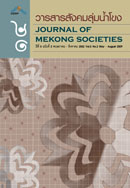Paper-cutting as A Local Isan Art
Main Article Content
Abstract
The objective of this article was to study the style, character, patterns, techniques, and processes, as well as the work involved in Northeast paper cutting, which is an Isan cultural heritage. The purpose is to use the findings as a guideline in conserving and encouraging paper-cutting and to value this unique art form. The research was done by studying previous literature as well as by interviewing paper-cutting artists. The study found that paper-cutting artists consisted of two groups: those using scissors. It focused on paper-cutters who used scissors in Khon Kaen and those who used chisels in Ubon Ratchathani province. The local paper-cuttings could be classified into two styles: two-dimensional forms and three-dimensional forms. Most of the art work used tinsel paper, cellophane, straw paper. Paper-cutting using scissors would use folded paper rather than chisel because chisels would be used for patterns that must be laid out with hard paper. Therefore, there were differences: there was more variety in patterns achieved by using scissors than those achieved by using a chisel because some cutting artists would spontaneously create a pattern themselves. Most of the patterns were created by combining Thai traditional patterns and the unique patterns of the artists. in addition the patterns were influenced by those of Laos and Cambodia. Paper-cutting used to be a part of the Isan people’s daily life, it also was used in traditional ceremonies as well as in the rites and beliefs of local people.


